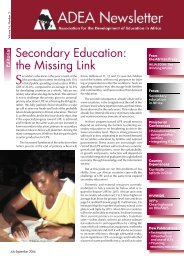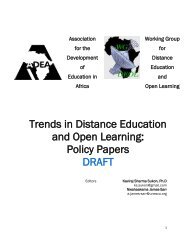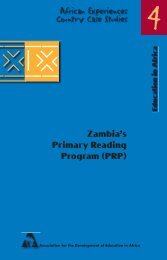Technological Infrastructure and Use of ICT in Education in ... - ADEA
Technological Infrastructure and Use of ICT in Education in ... - ADEA
Technological Infrastructure and Use of ICT in Education in ... - ADEA
Create successful ePaper yourself
Turn your PDF publications into a flip-book with our unique Google optimized e-Paper software.
<strong>Technological</strong> <strong>Infrastructure</strong> <strong>and</strong> <strong>Use</strong> <strong>of</strong> <strong>ICT</strong> <strong>in</strong> <strong>Education</strong> <strong>in</strong> Africa: an overview<br />
43<br />
(Moses & Croll, 1991). Of course, it can just as easily re<strong>in</strong>force authoritarian<br />
teacher-centred patterns.<br />
Multi-cultural classrooms are <strong>of</strong>ten sites <strong>of</strong> <strong>in</strong>visible, but very real,<br />
hegemonic struggle for cultural dom<strong>in</strong>ance (Walkerd<strong>in</strong>e, 1991). Thus, for<br />
example, the content <strong>of</strong> a geography lesson on ‘farm<strong>in</strong>g technology’ can<br />
benefit from video <strong>in</strong>formation on traditional <strong>and</strong> non-traditional methods<br />
<strong>of</strong> farm<strong>in</strong>g with which a teacher may be unfamiliar. Video resources<br />
can provide support to teachers with<strong>in</strong> a multi-cultural classroom, <strong>and</strong><br />
have the potential to challenge <strong>of</strong>ten-<strong>in</strong>visible resistance to alternative<br />
viewpo<strong>in</strong>ts <strong>in</strong> a classroom (Moses & Croll, 1991).<br />
Video-based learn<strong>in</strong>g resources can <strong>in</strong>troduce <strong>in</strong>terest<strong>in</strong>g factors <strong>in</strong>to<br />
debates about the merits <strong>of</strong> literacy versus oral-based learn<strong>in</strong>g <strong>and</strong><br />
cultures. The use <strong>of</strong> video resources such as archival footage might add<br />
to an underst<strong>and</strong><strong>in</strong>g <strong>of</strong> the history <strong>of</strong> a country. Because video resources<br />
most <strong>of</strong>ten are accompanied by audio tracks, they tend to rely on multiple<br />
media to present <strong>in</strong>formation that is neither purely oral nor purely literal.<br />
In this way, video can show behaviour, nuance, <strong>and</strong> relationships <strong>in</strong> a<br />
variety <strong>of</strong> contexts that simultaneously dem<strong>and</strong> oral <strong>and</strong> literary skills<br />
(Moses & Croll, 1991).<br />
The educational impact <strong>of</strong> video resources depends, at least <strong>in</strong> part, on<br />
the extent to which <strong>in</strong>structional designers <strong>in</strong>clude <strong>in</strong>teractive learn<strong>in</strong>g<br />
activities for students. Viewers, whether adults or children, do not come<br />
to the screen with ‘empty m<strong>in</strong>ds’, but have prior learn<strong>in</strong>g experiences that<br />
are relevant to how they access <strong>and</strong> use visual <strong>in</strong>formation. In an age<br />
where we are expected to receive, process, <strong>and</strong> discrim<strong>in</strong>ate between<br />
messages at very high levels, video resources need to challenge what<br />
students know <strong>and</strong> potentially can know. Integrat<strong>in</strong>g recognition <strong>of</strong> prior<br />
learn<strong>in</strong>g <strong>in</strong>to the <strong>in</strong>structional design process (especially <strong>of</strong> television<br />
broadcasts) is, however, complicated by the fact that audiences tend to<br />
be assumed to be ‘homogeneous’, while distribution <strong>of</strong> the message<br />
is ‘democratic’.<br />
A correlation exists between video comprehension <strong>and</strong> read<strong>in</strong>g<br />
comprehension, as does a cognitive <strong>in</strong>terdependence between view<strong>in</strong>g<br />
<strong>and</strong> read<strong>in</strong>g skills (Kelley & Gunter, 1996). <strong>Education</strong>ally, video’s<br />
strength is the attractiveness <strong>of</strong> its content, not its complexity. This is<br />
important for develop<strong>in</strong>g <strong>and</strong> us<strong>in</strong>g video resources <strong>in</strong> the classroom.<br />
Several <strong>in</strong>ternational studies have exam<strong>in</strong>ed this issue, <strong>and</strong> it is clear<br />
that learn<strong>in</strong>g from video is only possible if teachers <strong>and</strong> parents support<br />
4. Characteristics <strong>of</strong> Different Media

















